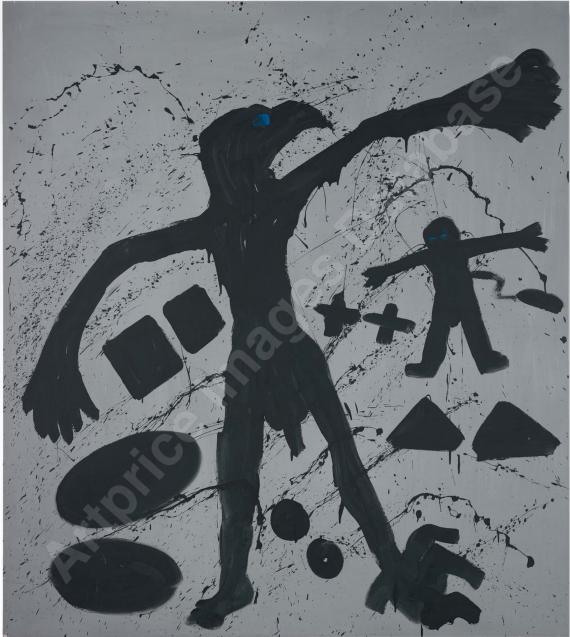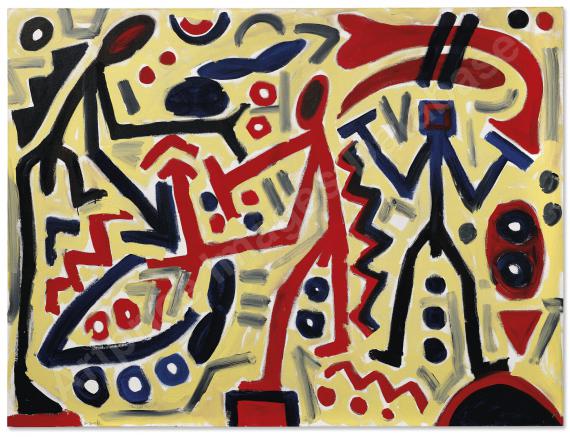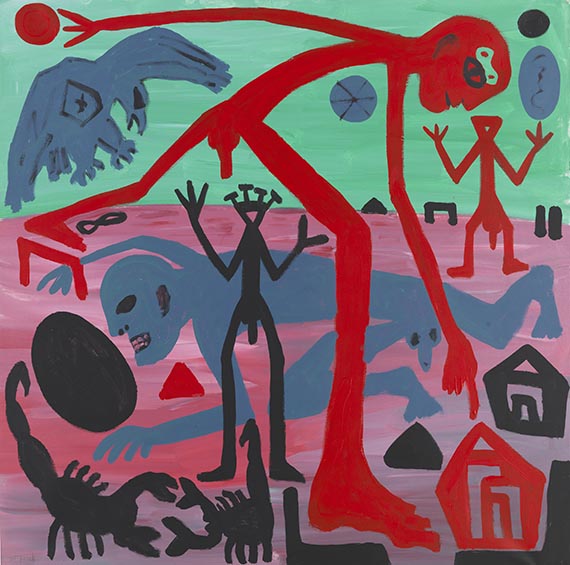54
A. R. Penck (d.i. Ralf Winkler)
Free Rock A, 1984.
Dispersion paint on canvas
Estimation: € 200,000 / $ 214,000
Free Rock A. 1984.
Dispersion paint on canvas.
Signed in the upper left. 200 x 151 cm (78.7 x 59.4 in).
• Penck played in a band called "TTT" in the 1980s - his passion for free jazz and improvised syncopation is reflected in "Free Rock A".
• He was similarly free and experimental in his music as he was in visual art; his art is unfiltered and raw.
• The logic and systematics of A. R. Penck's sign language are unique in German post-war art.
• For the first time offered on the international auction market (source: artprice.com).
PROVENANCE: Galerie Michael Werner, Cologne (with the gallery label on the reverse).
Galerie Michael Haas, Berlin (with the gallery label on the reverse).
Private collection, Berlin (acquired from the above in 1989).
EXHIBITION: A. R. Penck. Peintures des années 80, Galerie Gillespie-Laage-Solomon, Paris, June 6 - July 12, 1986 ( with the gallery label on the reverse).
Accrochage, Galerie Michael Werner, Cologne, May 12 - June 10, 1988.
Called up: June 7, 2024 - ca. 18.46 h +/- 20 min.
Dispersion paint on canvas.
Signed in the upper left. 200 x 151 cm (78.7 x 59.4 in).
• Penck played in a band called "TTT" in the 1980s - his passion for free jazz and improvised syncopation is reflected in "Free Rock A".
• He was similarly free and experimental in his music as he was in visual art; his art is unfiltered and raw.
• The logic and systematics of A. R. Penck's sign language are unique in German post-war art.
• For the first time offered on the international auction market (source: artprice.com).
PROVENANCE: Galerie Michael Werner, Cologne (with the gallery label on the reverse).
Galerie Michael Haas, Berlin (with the gallery label on the reverse).
Private collection, Berlin (acquired from the above in 1989).
EXHIBITION: A. R. Penck. Peintures des années 80, Galerie Gillespie-Laage-Solomon, Paris, June 6 - July 12, 1986 ( with the gallery label on the reverse).
Accrochage, Galerie Michael Werner, Cologne, May 12 - June 10, 1988.
Called up: June 7, 2024 - ca. 18.46 h +/- 20 min.
In his search for a universal sign language, Penck developed a very own fascinating artistic expression that moves somewhere between a strict, complicated system inscrutable from the outside and anarchy or expressive, gestural painting that is far from any sense of logic. In an interview with Florian Illies, Penck's artist friend Georg Baselitz explains: “He invents his alphabet, drawing from the depths of art and history, but still entirely his own. No one but him can read it. But we can look at it - and feel it [..] You don't have to ask why?” The abstract figures, symbols, and signs have no spatial reference, they seem to just float in the picture, and there is no real spatial perspective. Stick figures with large penises and armed with spears, guns or arrows and, as is the case in the present work, usually in some kind of confrontation with one or more other symbols like wheels, spirals or emblems emerged in the 1960s. In a nutshell, Penck's pictorial language consists of abstract figures, symbols, and signs. He developed a register of signs based on the idea that the reception of signals leads to a transformation into feelings and actions. As the artist put it in an essay: “Signs control behavior. Information controls behavior. Signs prompt or inhibit impulses, they cause arousal […] The pragmatic and magic art of the Ice Age man leads me to assume that the origin of art contained initial findings on sign research that were later forgotten” (quoted from Dieter Koepplin, in: Klaus Gallwitz (ed.) Gemeinschaftsbilder von H. Gallasch, W. Opitz, A. R. Penck, Terk, Dresden 1971-1976, ex. cat., no page).
By universalizing the pictorial language into a sign language, Penck offers the viewer the largest projection screen possible, allowing for a verification of the content based on their own experience, thus creating individual realities. He aims to reduce his works to a few unambiguous signs so clear that anyone can recognize and imitate them. Hence Penck developed this unmistakable pictogram style to clarify complex relationships and existential themes. Over several years, he developed a new visual language that followed its own logic. Penck's music is just as free and wild as his paintings. In addition to visual arts, he had a wide range of interests, including music, science, film, performance, and poetry. For many years, he played drums and piano in the extremely successful free jazz band “TTT” (“Triple Trip Touch”). Just as is the case in his paintings, his music is also characterized by long experimental improvisations of raw and unfiltered beauty. Penck and Frank Wollny recorded several albums with “TTT”, including with Frank Wright, Lawrence “Butch” Morris, Jeanne Lee, and Alan Silva. Penck designed album covers and concert posters in his unique visual language. Freedom and wildness characteristic of Penck's entire oeuvre is evident in “Free Rock A”. While his pictures are difficult to decipher, one just has to develop a feeling for them. Penck has not given us the code for his sign language, as that would kill their magic, instead we have to find the right mindset to discover their meaning. And that is, above all, what makes his works so fascinating. [SM/MvL]
By universalizing the pictorial language into a sign language, Penck offers the viewer the largest projection screen possible, allowing for a verification of the content based on their own experience, thus creating individual realities. He aims to reduce his works to a few unambiguous signs so clear that anyone can recognize and imitate them. Hence Penck developed this unmistakable pictogram style to clarify complex relationships and existential themes. Over several years, he developed a new visual language that followed its own logic. Penck's music is just as free and wild as his paintings. In addition to visual arts, he had a wide range of interests, including music, science, film, performance, and poetry. For many years, he played drums and piano in the extremely successful free jazz band “TTT” (“Triple Trip Touch”). Just as is the case in his paintings, his music is also characterized by long experimental improvisations of raw and unfiltered beauty. Penck and Frank Wollny recorded several albums with “TTT”, including with Frank Wright, Lawrence “Butch” Morris, Jeanne Lee, and Alan Silva. Penck designed album covers and concert posters in his unique visual language. Freedom and wildness characteristic of Penck's entire oeuvre is evident in “Free Rock A”. While his pictures are difficult to decipher, one just has to develop a feeling for them. Penck has not given us the code for his sign language, as that would kill their magic, instead we have to find the right mindset to discover their meaning. And that is, above all, what makes his works so fascinating. [SM/MvL]
54
A. R. Penck (d.i. Ralf Winkler)
Free Rock A, 1984.
Dispersion paint on canvas
Estimation: € 200,000 / $ 214,000
Commission, taxes et droit de suite
Cet objet est offert avec imposition régulière ou avec imposition différentielle.
Calcul en cas d'imposition différentielle:
Prix d'adjudication jusqu'à 800 000 € : 32 % de commission.
Prix d'adjudication supérieur à 800 000 € : montants partiels jusqu'à 800 000 € 32 % de commission, montants partiels supérieurs à 800 000 € : 27 % de commission.
La commission comprend la TVA, laquelle ne figure cependant pas sur la facture.
Calcul en cas d'imposition régulière:
Prix d'adjudication jusqu'à 800 000 € : 27 % de commission majorée de la TVA légale
Prix d'adjudication supérieur à 800 000 € : montants partiels jusqu'à 800 000 € 27 % de commission, montants partiels supérieurs à 800 000 € : 21 % de commission, à chaque fois majorés de la TVA légale.
Prix d'adjudication supérieur à 4.000 000 € : montants partiels supérieurs à 4.000 000 € : 15 % de commission, à chaque fois majorés de la TVA légale.
Si vous souhaitez appliquer l'imposition régulière, merci de bien vouloir le communiquer par écrit avant la facturation.
Calcul en cas de droit de suite:
Concernant les objets réalisés par un artiste dont le décès remonte à moins de 70 ans, des droits de suite seront facturés qui s'élèvent à 2,4 % de la TVA légale incluse.
Calcul en cas d'imposition différentielle:
Prix d'adjudication jusqu'à 800 000 € : 32 % de commission.
Prix d'adjudication supérieur à 800 000 € : montants partiels jusqu'à 800 000 € 32 % de commission, montants partiels supérieurs à 800 000 € : 27 % de commission.
La commission comprend la TVA, laquelle ne figure cependant pas sur la facture.
Calcul en cas d'imposition régulière:
Prix d'adjudication jusqu'à 800 000 € : 27 % de commission majorée de la TVA légale
Prix d'adjudication supérieur à 800 000 € : montants partiels jusqu'à 800 000 € 27 % de commission, montants partiels supérieurs à 800 000 € : 21 % de commission, à chaque fois majorés de la TVA légale.
Prix d'adjudication supérieur à 4.000 000 € : montants partiels supérieurs à 4.000 000 € : 15 % de commission, à chaque fois majorés de la TVA légale.
Si vous souhaitez appliquer l'imposition régulière, merci de bien vouloir le communiquer par écrit avant la facturation.
Calcul en cas de droit de suite:
Concernant les objets réalisés par un artiste dont le décès remonte à moins de 70 ans, des droits de suite seront facturés qui s'élèvent à 2,4 % de la TVA légale incluse.




 Lot 54
Lot 54 



